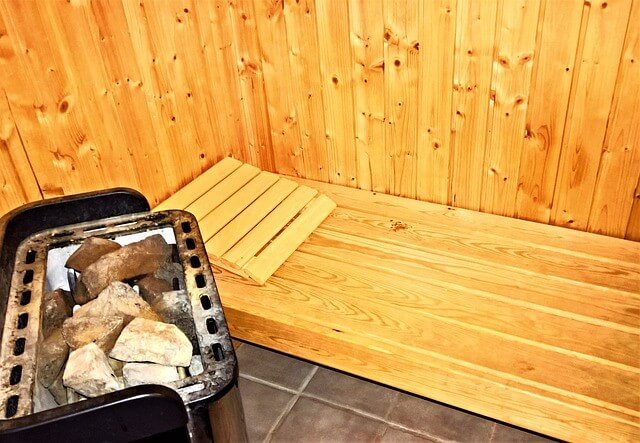A sauna can be said as part of Finnish history because the oldest known saunas were found in Finland. People dug pits inside the slopes and used it as a dwelling place in winter.
The sauna contained a fireplace where the stones were heated at a high temperature. Water was poured on these stones to produce steam. As a result, the surrounding temperature increased, causing people to sweat. As the Finns migrated to different parts of the globe, they took this practice with them.
Similarly, the Koreans too practiced this culture, but theirs was known as
What is a sauna bath?
A sauna is a room that is heated to a temperature between 65°C to 90°C. These rooms have wooden interiors, are not painted, and have temperature controls.
As part of their heating element, it may contain rocks that absorb and gives off heat. Pouring water on these rocks gives off steam. The high heat and the steam opens up your skin pores and make you sweat. After your final round, take a refreshing bath to close the pores of your skin.
Benefits of a sauna bath
Sauna relaxes your body and mind. This process transitions between hot and cold. Relaxing in a scented hot sauna may be the best part of your gym workout or during your vacation. Saunas provide health benefits whether you enjoy it weekly or once a year.
Improves cardiovascular performance
Bathers say that they feel stress-free after a relaxing bath. Stress harms your body; likewise, stress aggravates many heart diseases. Relaxing in a warm, quiet sauna soothes your muscles, stimulates the feel-good hormones, and significantly improves circulation. Sweating induced by the heat and steam is highly beneficial for people with COPD, congestive heart failure, and peripheral arterial disease.
Flushes toxins
A sauna is one of the best ways to detoxify your body. The heat increases your core body temperature. As a result, blood vessels dilate, causing increased blood flow. Soon your body starts to sweat. Deep sweating
Reduces the risk of Alzheimer’s disease
A 20-year research study by the University of Eastern Finland with more than 2,300 participants found that regular sauna use for at least 4 to 7 times a week for about 19 minutes reduced the risk of Alzheimer’s and Dementia.
Fights illness
A relaxing hot bath is helpful for muscle recovery after sports — also, sauna bathing help to reduce the symptoms of rheumatoid arthritis.
Sauna safety tips
Saunas may not be for everyone. Consult your doctor before using a sauna if you have diabetes, uncontrolled high blood pressure, abnormal heart rhythm, heart failure, or unstable angina. Limit your usage to just 5 minutes per visit if you have these health conditions.
Likewise, cool down your body slowly. Avoid using a sauna if you take medicines that interfere with your body’s ability to regulate temperature or medications that make you drowsy.
To avoid dehydration, drink a glass of water before you enter a sauna. Avoid alcohol and recreational drugs before, during, and after use. Never let yourself fall asleep in a sauna. Never sit in it for more than 10 to 15 minutes.
If you’re new, then try to sit for only 5 to 10 minutes and allow your body to build up a tolerance for heat over multiple visits.
The Finnish tradition asks you to take a plunge in cold water after your sauna experience. This practice may not be suitable for you if you’re pregnant or have heart or other health conditions. Immediately exit the sauna if you’re dizzy or feeling ill.
Be careful while using a sauna if you’re pregnant or planning for motherhood. To be on the safer side, check with your doctor. The National Health Service warns that overheated sauna may be dangerous for mother and the child.
Hot tub safety
Hot tub temperatures must be between 100° and 104° F. A research study on 21 people who had hypertension found that sitting in a hot tub reduced blood pressure, but it never approached unsafe levels. Another study of 15 men with stable coronary artery disease showed that spending 15 minutes on a hot tub produced less circulatory stress than 15 minutes on a stationary bike.
To be on the safer side, follow the guidelines provided when you’re in the hot tub. Make sure the hot tub is clean and well chlorinated. A dirty hot tub can cause folliculitis-a skin infection resulting from a poorly maintained hot tub.














